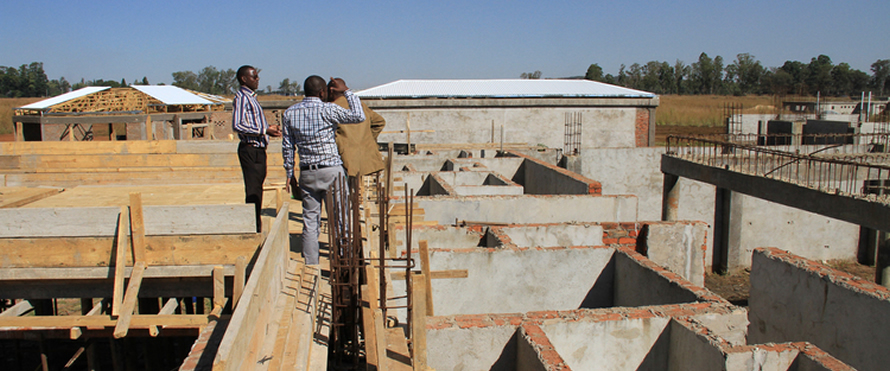
The Sunday Mail

 A view of the Zimbabwe Diamond Technology Centre which is under construction in Mt Hampden. The first phase of the centre is expected to be commissioned at the end of this month
A view of the Zimbabwe Diamond Technology Centre which is under construction in Mt Hampden. The first phase of the centre is expected to be commissioned at the end of this monthKuda Bwititi
The growing disillusionment over the meagre earnings from diamond exports has led experts to call for the speeding up of beneficiation in the diamond sector, taking lessons from other diamond producing and other non-producing countries which dominate the billion dollar gem trade.Beneficiation entails the value addition of minerals by processing them to attain higher returns.
Since December last year when Zimbabwe officially commenced public auction of the diamonds, the country has only raked in a gross total of US$110 million from the three diamond auctions that were conducted in Antwerp and in Dubai.
Out of this, treasury has collected just about US$15 million, which is way below expectations and comes in the wake of revelations by officials from the Ministry of Finance and Economic Development that they have since stopped making projections of diamond revenue.
This is all the more disappointing when one considers that a March 13, 2014 report by Paul Zimnisky on Mining.com stated that Marange diamond fields were rated amongst the world’s largest source of diamonds in terms of carats produced in 2013 after approximately 17 million carats were mined from the Chiadzwa fields.
Almost all these diamonds were shipped to foreign auctions where there were virtually sold for peanuts.
International diamond markets such as Antwerp and Dubai are openly scrambling to buy the rough diamonds from Marange as dealers from these centres realise that they stand to benefit more when they add value to the stones.
Whilst the international dealers make hay with their catch, disappointments in the diamond sector have become all too apparent.
Recent reports of delays in accessing the US$30 million proceeds from diamonds sold in Dubai, as well allegations by Antwerp Chief Ari Epstein over the price disparity of the diamonds paint a sad picture of the revenue returns from diamonds.
Experts say that the country can realise up to 10 times more value from diamonds by adding value to the stones through cutting and polishing.
Resource Exploitation Watch Chairman Mr Tafadzwa Musarara believes the value addition of diamonds is a must if the country is to attain maximum benefits from the gemstones.
“It is imperative for the country to do forward integration in the diamond sector. There are so many advantages that come with adding value to the diamonds.
“First and foremost, if we cut and polish the stones it means that the product falls outside the KPCS (Kimberly Processing Scheme) and effectively ensures that such a diamond can be sold anywhere in the world without the influence of KPCS.
“This is opposed to rough diamonds which need KP certification and therefore are bound by certain restrictions.”
According to Mr Musarara, India which has been one of the biggest consumers of diamonds from Marange in the past few years has realised massive benefits by adding value to rough diamonds from Zimbabwe.
“At one time, India imported diamonds worth US$14 billion but through value addition, it sold them to other markets for US$40 billion.”
In 2012, the Indian city of Surat reportedly created 100 000 jobs which were a direct result of raw diamonds that were imported from Zimbabwe.
In the region, Zimbabwe is the only diamond-producing country that is yet to establish a diamond industry to process the precious stones through cutting and polishing.
Botswana has been able to develop its diamond sector through the Diamond Technology Park, which is a hub for the cutting and polishing of diamonds.
This is despite the fact that rough diamonds from Botswana fetch a higher price than those from Marange because they have higher gem quality.
The DTP rakes in up to US$1 billion annually through the beneficiation of diamonds.
It employs more than 3 000 people and attracts international dealers from all over the globe.
Chairman of the Zimbabwe Diamond Technology Centre Mr Lovemore Kurotwi, who toured the DTP last month on a fact finding mission said companies at the centre import diamonds from other countries to add value to the stones.
“I found it interesting that some companies at the centre actually import diamonds from other countries because they realise that they stand to gain more by cutting and polishing the stones.
“The concept of Diamond Technology Park is that of a supply chain cluster housing the entire diamond industry in a one-stop shop. It ensures that there is accountability and transparency of diamonds. The value of every stone is known.
“We have learnt crucial lessons from Botswana and we are modelling our own centre in the same fashion,” he said.
Other diamond producing countries, South Africa, Lesotho and Namibia, all have diamond centres for the beneficiation of diamonds to go a gear up from mining the gems.
The global diamond cutting and polishing trade is valued at US$47 billion while jewellery is at US$71 billion.
However, this billion dollar diamond industry has been dominated by non-producing countries such as the United States, Belgium, India, Dubai and Israel.
A few weeks ago, the Ministry of Mines and Mining Development enacted Statutory Instrument 79 of 2014 on the diamond sector to encourage beneficiation.
Under the Statutory Instrument, all local diamond manufacturers who purchase diamonds locally are encouraged to cut and polish the stones.
The enactment of the statutory instrument brings hope that the country will establish a vibrant diamond industry that can meaningfully contribute to economic development by tapping into the billion dollar processing industry.



